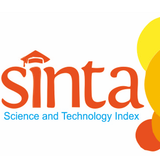Technique of Dietary Supplementation of Guanidinoacetic Acid for Growth Improvement of Catfish (Pangasius hypophthalmus)
DOI:
https://doi.org/10.31851/jipbp.v18i1.11368Keywords:
Coating, Pelleting, Guanidinoacetic acid, Pangasius CatfishAbstract
The present study aims to determine the best technique of Guanidinoacetic acid (GAA) supplementation to improve retention of added GAA after immersion in water on the growth performance of Pangasius catfish (Pangasius hypophthalmus). Pangasius catfish juveniles with a mean body weight and length of 16.05 ± 0.47 g and 12.42 ± 0.30 cm were randomly distributed into 9 pond units (2 x 1 x 0,6 m). Three experimental diets were formulated to contain (0,5% kg-1 GAA) with different technique of GAA supplementation, i.e. control, pelleting technique and spray-coating technique fed to the fish for 60 days of culture. The results showed that average body weight and biomass of fish fed diet with by GAA supplementation with the pelleting technique was higher (p<0.05) than that of spray-coating technique and control. In conclusion, the consumption of diets containing GAA with pelleting technique resulted the best growth performance of Pangasius catfish (Pangasius hypophthalmus).
Penelitian ini bertujuan untuk menentukan metode terbaik dalam suplementasi Guanidinoacetic acid (GAA) pada pakan untuk meningkatkan retensi penambahan GAA setelah perendaman di air dalam meningkatkan kinerja pertumbuhan ikan patin (Pangasius hypophthalmus). Benih ikan patin dengan rata-rata bobot 16.05 ± 0.47 g dan panjang 12.42 ± 0.30 cm dipelihara di dalam 9 unit kolam dengan ukuran (2 x 1 x 0,6 m). Ikan diberikan pakan selama 60 hari pemeliharaan tiga perlakuan yaitu; kontrol (tanpa penambahan GAA); perlakuan pelleting (penambahan 0,5% kg/GAA); dan perlakuan spray coating (penambahan 0,5% kg/GAA). Hasil penelitian menunjukkan bahwa perlakuan penambahan 0,5% kg/GAA dengan metode pelleting memberikan rata-rata bobot ikan dan biomasa paling tinggi dibandingkan dengan perlakuan lain dan kontrol (p<0.05). Kesimpulan dari penelitian ini adalah suplementasi GAA pada pakan ikan patin dengan metode pelleting menunjukkan kinerja pertumbuhan terbaik jika dibandingkan dengan metode spray coating pada ikan patin.
References
Arif M, Anam A, Nurhajati, Lamid M, and Sidik R, Al-Arif, MA, T Nurhajati, R Sidik, M Lamid, Setyono, and Lokapirnasari. 2016. Buku Ajar Teknologi Pakan Hewan Surabaya: Revka Petra Media.
APHA. 1998. Standard Methods for The Examination of Water and Wastewater. Washington: American Public Health Association.
Aziza, A., Mahmoud, R., Zahran, E., Gadalla, H., 2020. Dietary supplementation of guanidinoacetic acid improves growth, biochemical parameters, antioxidant capacity and cytokine responses in Nile tilapia (Oreochromis niloticus). Fish Shellfish Immun 97, 367–374.
Baker, D. H. 2009. Advances in protein-amino acid nutrition of poultry. Amino Acids, 37: 29–41.
Bekara, C., Laurent-Maknavicius, M. and Bekara, K. 2007. In vitro and in vivo studies of creatine monohydrate supplementation to Duroc and Landrace pigs. Meat Science, 76: 342–351.
D.C. Little, R. Newton, M. Beveridge, Aquaculture: a rapidly growing and significant source of sustainable food? Status, transitions and potential, J Proc. Nutrition Society (2016) 274–286.
El Sayed MR, Aziza A, Ali GH. 2019. Influence of guanidinoacetic acid supplementation of fish diets with different levels of energy content on growth performance and serum metabolites. Journal of Veterinary Science & Animal Husbandry. 7(3): 1-7.
Esser AFG, Gonçalves DRM, Rorig A, Cristo AB, Perini R. 2017. Effects of guanidionoacetic acid and Arginine supplementation to vegetable diets fed to broiler chickens subjected to heat stress before slaughter. Br J of Poult Sci. 19: 429-36.
Fu Q., Qiao, L. H., Tang, Z. G., Wen, Q., Liu, W. B. and Zou, Y. M. 2015. Effects of guanidino acetic acid on growth performance, body composition and key enzymes of energy metabolism of muscle in Jian Carp (Cyprinus carpio var Jian). Journal of the Chinese Cereals and Oils Association, 30: 85–89 (in Chinese with English abstract).
Guimaraes-Ferreira L. 2014. Role of phosphocreatine system on energetic homeostatis in skeletal and cardiac muscles. Einstein (Sao Paulo). 12: 126-131.
Hermiastuti, Meirinda. 2013. Analisis Kadar Protein dan Identifikasi Asam Amino pada Ikan Patin (Pangasius djambal). Thesis Chemistry Faculty of Math and Science Universitas Jember (Jember).
Haussinger, D. 1996. The role of cellular hydration in the regulation of cell function. Biochemistry Journal, 313: 697–710.
Huang K and Nitin N. 2019. Edible bacteriophage based antimicrobial coating on fish feed for enhanced treatment of bacterial infections in aquaculture industry. Aquaculture, 502: 18-25.
Liu, Y., Li, J.L., Li, Y.J., Gao, T., Zhang, L., Gao, F., Zhou, G.H., 2015. Effects of dietary supplementation of guanidinoacetic acid and combination of guanidinoacetic acid and betaine on postmortem glycolysis and meat quality of finishing pigs. Anim. Feed Sci. Technol. 205, 82–89.
Michiels, J., Maertens, L., Buyse, J., Lemme, A., Rademacher, M., Dierick N. A. and De Smet, S. 2012. Supplementation of guanidinoacetic acid to broiler diets: Effects on performance, carcass characteristics, meat quality, and energy metabolism, Poultry Science, 91: 402–412.
Mousavi, S. N., Afsar, A. and Lotfollahian, H. 2013. Effects of guanidinoacetic acid supplementation to broiler diets with varying energy contents. Journal of Applied Poultry Research, 22: 47–54.
Ostogic SM, Niess B, Stojanovic M, Obrenovic M. 2013. Creatine metabolism and safety profiles after six-week oral guanidinoacetic acid administration in healthy humans. Int J Med Sci. 10: 141-147.
Ostojic SM, Stojanovic MD, Hoffman JR. 2014. Dose–response effects of oral guanidinoacetic acid on serum creatine, homocysteine and B vitamins levels. European journal of nutrition. 53(8): 1637-1643.
Ostojic SM, Stojanovic MD, Olcina G. 2015. Oxidant-antioxidant capacity of dietary guanidinoacetic acid. Ann. Nutr. Metab. 67(4): 243–246.
Ringel, J., Lemme, A., Knox, A., Mc Nab, J. and Redshaw, M. S. 2007. Effects of graded levels of creatine and guanidine acetic acid in vegetable-based diets on performance and biochemical parameters in muscle tissue.16th European Symposium on Poultry Nutrition, 387-390.
Stahl, C. A. M. W., Greenwood, M. W. and Berg, E. B. 2003. Growth parameters and carcass quality of broilers fed a corn-soybean diet supplemented with creatine monohydrate. International Journal Poultry Science, 2: 404-408.
Wang, L. S. Shi, B. M. Shan, A. S. and Zhang, Y. Y. 2012. Effects of guanidinoacetic acid on growth performance, meat quality, and antioxidation in growing-finishing pigs. Journal of Animal & Veterinary Advances, 11: 631–636.
Wyss, M. and Kaddurah-Daouk R. 2000. Creatine and creatinine metabolism. Physiol. Rev., 80: 1107–1213.
Yazdi, F.T., Golian, A., Zarghi, H., Varidi, M., 2017. Effect of wheat-soy diet nutrient density and guanidine acetic acid supplementation on performance and energy metabolism in broiler chickens. Ital. J. Anim. Sci. 16, 593–600.
Zeng, Q., Rahimnejad, S., Wang, L., Song, K., Lu, K., Zhang, C., 2017. Effects of guanidinoacetic acid supplementation in all-plant protein diets on growth, antioxidant capacity and muscle energy metabolism of bullfrog Rana (Lithobates) catesbeiana. Aquac. Res. 49, 748–756.
Zhang, L., Li, Q., Lyu, J., Kong, C., Song, S., Luo, Y., 2017. The impact of stunning methods on stress conditions and quality of silver carp (Hypophthalmichthys molitrix) fillets stored at 4 degrees C during 72 h postmortem. Food Chem. 216, 130–137.
Downloads
Published
How to Cite
Issue
Section
License
Copyright (c) 2023 Aldi Huda Verdian, Rio Yusufi Subhan, Nurul Fatimah

This work is licensed under a Creative Commons Attribution-NonCommercial-ShareAlike 4.0 International License.
Jurnal Ilmu-ilmu Perikanan dan Budidaya Perairan by http://www.univpgri-palembang.ac.id/e_jurnal/index.php/ikan is licensed under a Creative Commons Attribution-ShareAlike 4.0 International License.









